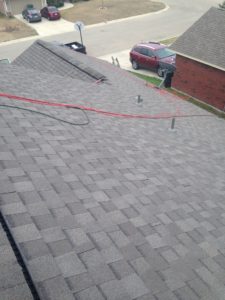 Asphalt shingles are the most popular roofing material installed on American structures. They are relatively easy to install and have a lower up-front cost than other types of roof coverings, such as slate or tile. Asphalt shingles are available in a variety of style and colors, making them one of the most versatile roofing materials on the market. Because they are so commonplace, many people do not realize that asphalt shingles are a relatively modern invention.
Asphalt shingles are the most popular roofing material installed on American structures. They are relatively easy to install and have a lower up-front cost than other types of roof coverings, such as slate or tile. Asphalt shingles are available in a variety of style and colors, making them one of the most versatile roofing materials on the market. Because they are so commonplace, many people do not realize that asphalt shingles are a relatively modern invention.
Asphalt Roofing Before 1900
Prior to 1900, there were no asphalt shingles. The first asphalt roofing came in rolls — similar to what is called roll roofing today but lacking granules on the surface. By 1897, companies began to experiment with different types of granules, including slate, mica, clay, oyster shells and silica. At this time, all asphalt roofing consisted of an organic base material that was normally cotton rag.
Asphalt Shingles From 1901 to 1920
Around 1901, someone — normally credited as a Michigan roofer named Henry Reynolds — had the idea of cutting rolls of asphalt roofing into individual shingles that would be easier to position and install. The idea caught on, and by 1915, shingle manufacturers began producing pre-cut shingles. However, these were often irregular shapes rather than the strip shingles on the market today. Asphalt shingles received a boost in popular after the National Board of Fire Underwriters launched a campaign against wood shingles in 1911.
Asphalt Shingles From the 1920s to the 1950s
During the 1920s, rag cotton soared in price, so manufacturers began using other organic materials for the base. Wood pulp, wool and jute were some of the materials used during this era. During the 1940s, synthetic fibers began to appear in rags, and since these synthetics resisted asphalt absorption, manufacturers turned to paper or wood pulp. By the 1950s, manufacturers began to standardize shingle sizes, and the first self-sealing asphalt shingles appeared.
Asphalt Shingles Since 1960
The first asphalt shingles to use a fiberglass mat as a base appeared in 1960. However, these early shingles were somewhat fragile and susceptible to breakage during installation. They did not resist wind or hail damage as well as organic shingles. By the late 1970s, manufacturers had overcome the problems of fiberglass shingles, and today, an estimated 95 percent of all asphalt shingles produced use a fiberglass base.
As the 21st century dawned, manufacturers began responding to increased consumer demand for asphalt shingles that were more architecturally interesting. New colors, three-dimensional effects and asphalt shingles that mimic other types of roofing materials are just some of the more recent entries in the history of asphalt shingles.
About Alpha Roofing
At Alpha Roofing, we have been installing asphalt shingles for more than 30 years. Our crews are all roofing professionals who work only for us and who share our commitment to quality. In addition to installing asphalt shingles, we also offer repairs, cleaning and roof inspections. We can install siding, skylights, flashing, and we install metal and low-slope roofing systems. We offer free quotes; just submit our online form or call us at (512) 777-1086.
